
Argo Navis, or simply Argo, is one of Ptolemy's 48 constellations, now a grouping of three IAU constellations. It is formerly a single large constellation in the southern sky. The genitive is "Argus Navis", abbreviated "Arg". Flamsteed and other early modern astronomers called it Navis, genitive "Navis", abbreviated "Nav".

In Greek mythology, Cerberus, often referred to as the hound of Hades, is a multi-headed dog that guards the gates of the Underworld to prevent the dead from leaving. He was the offspring of the monsters Echidna and Typhon, and was usually described as having three heads, a serpent for a tail, and snakes protruding from his body. Cerberus is primarily known for his capture by Heracles, the last of Heracles' twelve labours.
Kerberos is a computer-network authentication protocol that works on the basis of tickets to allow nodes communicating over a non-secure network to prove their identity to one another in a secure manner. Its designers aimed it primarily at a client–server model, and it provides mutual authentication—both the user and the server verify each other's identity. Kerberos protocol messages are protected against eavesdropping and replay attacks.

Leo is one of the constellations of the zodiac, between Cancer the crab to the west and Virgo the maiden to the east. It is located in the Northern celestial hemisphere. Its name is Latin for lion, and to the ancient Greeks represented the Nemean Lion killed by the mythical Greek hero Heracles as one of his twelve labors. Its old astronomical symbol is (♌︎). One of the 48 constellations described by the 2nd-century astronomer Ptolemy, Leo remains one of the 88 modern constellations today, and one of the most easily recognizable due to its many bright stars and a distinctive shape that is reminiscent of the crouching lion it depicts.

Hydra is the largest of the 88 modern constellations, measuring 1303 square degrees, and also the longest at over 100 degrees. Its southern end borders Libra and Centaurus and its northern end borders Cancer. It was included among the 48 constellations listed by the 2nd century astronomer Ptolemy. Commonly represented as a water snake, it straddles the celestial equator.

Hercules is a constellation named after Hercules, the Roman mythological hero adapted from the Greek hero Heracles. Hercules was one of the 48 constellations listed by the second-century astronomer Ptolemy, and it remains one of the 88 modern constellations today. It is the fifth-largest of the modern constellations and is the largest of the 50 which have no stars brighter than apparent magnitude +2.5.

Mons Maenalus was a constellation created by Johannes Hevelius in 1687. It was located between the constellations of Boötes and Virgo, and depicts a mountain in Greece that the herdsman is stepping upon. It was increasingly considered obsolete by the latter half of the 19th century. Its brightest star is 31 Boötis, a G-type giant of apparent magnitude 4.86m.

Ramus Pomifer was a constellation between Hercules and Lyra.
Cerberus is a mythic multi-headed dog.

Kerberos Productions Inc. is a video game developer based in Vancouver, British Columbia, Canada. The company was formed in 2003 by former employees of Rockstar Vancouver.

1865 Cerberus is a stony asteroid and near-Earth object of the Apollo group, approximately 1.6 kilometers in diameter. It was discovered on 26 October 1971, by Czech astronomer Luboš Kohoutek at the Hamburger Bergedorf Observatory, Germany, and given the provisional designation 1971 UA. It was named for Cerberus from Greek mythology.

Former constellations are old historical Western constellations that for various reasons are no longer widely recognised or are not officially recognised by the International Astronomical Union (IAU). Prior to 1930, many of these defunct constellations were traditional in one or more countries or cultures. Some only lasted decades but others were referred to over many centuries. All are now recognised only for having classical or historical value. Many former constellations had complex Latinised names after objects, people, or mythological or zoological creatures. Others with unwieldy names were shortened for convenience. For example, Scutum Sobiescianum was reduced to Scutum, Mons Mensae to Mensa, and Apparatus Sculptoris to Sculptor.

The Red Spectacles is a 1987 Japanese surrealist science fiction neo-noir film directed by Mamoru Oshii, co-written with Kazunori Ito, and starring Shigeru Chiba and Mako Hyodo. The first film in Oshii's Kerberos Saga, but the second installment overall after its radio drama companion piece While Waiting for the Red Spectacles, the film follows Kōichi Todome, a former police detective who, after fleeing Japan following a failed rebellion by his dissolved unit, returns several years later per a promise to his colleagues, only to find Tokyo completely unrecognizable and increasingly strange and surreal.

Kerberos is a small natural satellite of Pluto, about 19 km (12 mi) in its longest dimension. Kerberos is also the second-smallest moon of Pluto, after Styx. It was the fourth moon of Pluto to be discovered and its existence was announced on 20 July 2011. It was imaged, along with Pluto and its four other moons, by the New Horizons spacecraft in July 2015. The first image of Kerberos from the flyby was released to the public on 22 October 2015.
109 Herculis is a single star in the northern constellation of Hercules. It is visible to the naked eye as a faint, orange-hued point of light with an apparent visual magnitude of 3.84. The star is located around 118.8 light-years distant, based on parallax. It is moving closer to the Earth with a heliocentric radial velocity of −58 km/s, and may come as close as 81 light-years away in around 328,000 years.
102 Herculis is a single star in the northern constellation of Hercules. It is visible to the naked eye as a faint, blue-white hued star with an apparent visual magnitude of 4.37. Based upon parallax measurements, it is located around 920 light years away from the Sun. The star is moving closer to the Earth with a heliocentric radial velocity of −15 km/s.
93 Herculis is a star located around 750 light years away from the Sun in the northern constellation of Hercules. It is visible to the naked eye as a faint, orange-hued star with an apparent visual magnitude of 4.67 The brightness of the star is diminished by an extinction of 0.21 due to interstellar dust. It is moving closer to the Earth with a heliocentric radial velocity of −24.5 km/s. This star, together with 95 Her, 102 Her, and 109 Her, made up the obsolete constellation Cerberus.

Urania's Mirror; or, a view of the Heavens is a set of 32 astronomical star chart cards, first published in November 1824. They are illustrations based on Alexander Jamieson's A Celestial Atlas, but the addition of holes punched in them allow them to be held up to a light to see a depiction of the constellation's stars. They were engraved by Sidney Hall, and were said to be designed by "a lady", but have since been identified as the work of the Reverend Richard Rouse Bloxam, an assistant master at Rugby School.
In Greek mythology, Cerberus may refer to a character and a mythical canine:

Kerberos ("Cerberus") is an extinct genus of hyainailourid hyaenodonts in the subfamily Hyainailourinae, that lived in Europe. It contains the single species Kerberos langebadreae.














